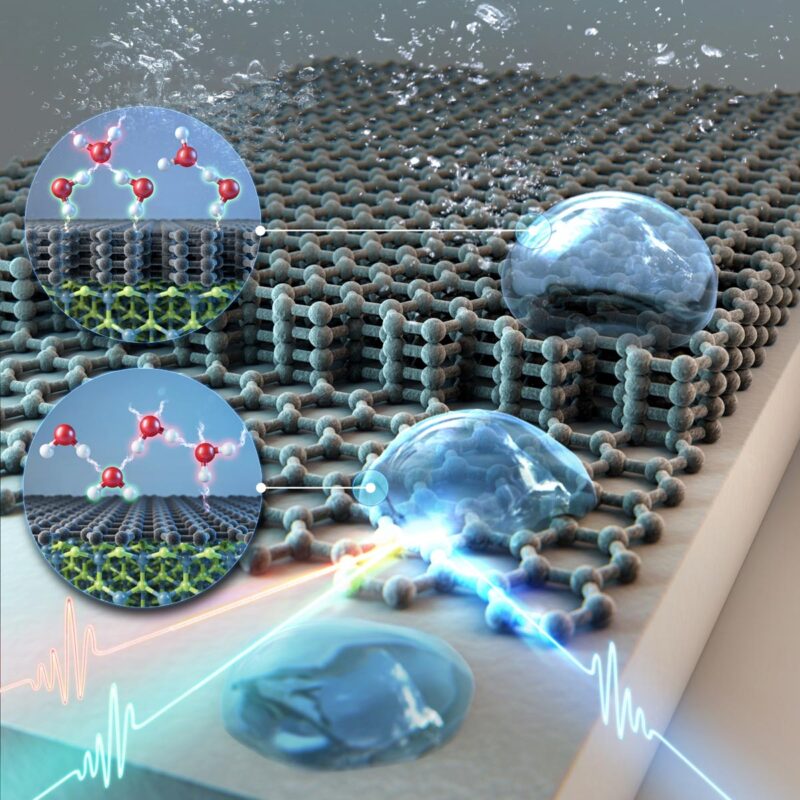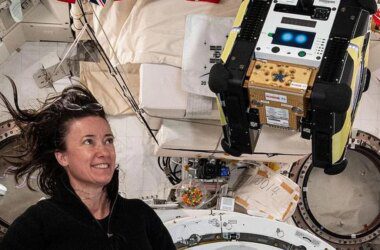
Les mesures de l’angle de contact du graphène avec l’eau donnent des informations sur la mouillabilité macroscopique. D’autre part, l’expérience VSFG peut fournir des informations sur la structure microscopique de l’eau interfaciale et la mouillabilité du graphène. Crédit : Institut des sciences fondamentales
La mesure microscopique de la mouillabilité peut être réalisée au niveau moléculaire en utilisant la “spectroscopie de génération de somme de fréquences vibratoires” (VSFG).
La mouillabilité du matériau est la capacité d’un liquide à maintenir le contact avec une surface solide, et elle est proportionnelle à l’hydrophilie et inversement proportionnelle à l’hydrophobie. C’est l’une des propriétés les plus importantes d’un solide, et la compréhension de la mouillabilité de différents substrats est essentielle pour une variété d’applications industrielles, telles que le dessalement, les agents de revêtement et les électrolytes de l’eau.
Jusqu’à présent, la plupart des études sur la mouillabilité des substrats ont été menées au niveau macroscopique. La mesure macroscopique de la mouillabilité est généralement déterminée en mesurant l’angle de contact avec l’eau (WCA), qui est l’angle que fait une goutte d’eau par rapport à la surface du substrat. Cependant, il est actuellement extrêmement difficile de mesurer avec précision ce qui se passe à l’interface entre un substrat et l’eau au niveau moléculaire.
Les techniques de mesure microscopiques actuellement utilisées, telles que la spectroscopie infrarouge par réflexion ou la spectroscopie Raman, sont incapables d’observer sélectivement les molécules d’eau interfaciales. Étant donné que le nombre de molécules d’eau dans l’ensemble du liquide est beaucoup plus important que celui des molécules qui entrent en contact avec la surface, le signal des molécules d’eau interfaciales est masqué par le signal des molécules d’eau dans l’ensemble du liquide.
Pour surmonter cette limitation, une équipe de recherche du Center for Molecular Spectroscopy and Dynamics (CMSD) au sein de l’Institute for Basic Science (IBS) à Séoul, en Corée du Sud, et de l’Université de Corée a révélé que la spectroscopie vibrationnelle par génération de somme de fréquences (VSFG) pouvait être utilisée pour mesurer la mouillabilité des matériaux 2D. L’équipe a réussi à mesurer le mode vibrationnel des molécules d’eau dans les interfaces entre graphene and water using VSFG spectroscopy.

(Left) VSFG spectra of interfacial water show that a dangling OH peak (3600 cm-1) appears when the graphene is more than 4 layers thick. (Right) The calculated VSFG wettability is plotted against adhesion energy from macroscopic observation. Both values coincide closely, which indicates increasing hydrophobicity as the number of graphene layers increases. Credit: Institute for Basic Science
VSFG is a useful technique that can connect the macroscopic measurement results with molecular-level properties. It is a surface-selective tool for investigating interfacial molecules using its own surface selection rule, and it has a very good surface resolution with a few molecular layers.
The group identified the unique ability of the graphene to project the wettability of the substrate onto its surface, which is called ‘wetting transparency’. They observed that the wetting transparency of graphene diminish as the number of graphene layers increased, disappearing when the graphene is more than 4 layers thick. This is the first observation to describe that graphene surface becomes hydrophobic above a certain number of layers at the molecular level.
Also, the researchers defined the new concept of VSFG wettability, which is the ratio of water molecules forming strong hydrogen bonds against water molecules with weak or no hydrogen bond formation. The VSFG wettability correlated strongly with the adhesion energy, which is calculated from the observed macroscopic WCA measurements. This proved that VSFG is an effective tool for defining the wettability of a material’s surface.
Using VSFG wettability, the researchers measured the wettability of the graphene in real-time, as an electric field was applied for it to form graphene oxide. It is impossible to observe wettability in real-time with the traditional WCA experiments. Therefore, this suggests that VSFG could be a decisive technique for measuring the water adhesion energy on any spatially confined interface where the water contact angle measurement cannot be applied. In addition to graphene, VSFG spectroscopy is expected to shed light on the wettability of other low-dimensional materials.
First author Eunchan Kim notes: “This study confirmed that VSFG spectroscopy could be used as a versatile tool for measuring the wettability.”, and “We demonstrate the potential to measure the wettability of previously unobservable complex systems through VSFG spectroscopy.”
Professor CHO Minhaeng, the Director of CMSD notes: “With VSFG spectroscopy, we are studying the microscopic properties of graphene as well as other two-dimensional functional materials such as graphene oxide and hexagonal boron nitride.”, and “Through this, it will be possible to solve various problems that hinder the commercialization of two-dimensional functional materials.”
This research was published in the online edition of Chem (IF 22.804) on April 26th, 2022.
Reference: “Wettability of graphene, water contact angle, and interfacial water structure” by Eunchan Kim, Donghwan Kim, Kyungwon Kwak, Yuki Nagata, Mischa Bonn and Minhaeng Cho, 26 April 2022, Chem.
DOI: 10.1016/j.chempr.2022.04.002



